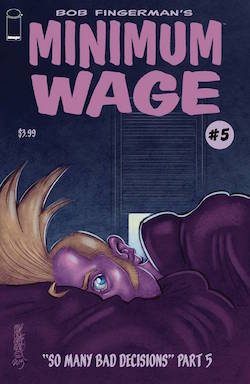Thursday Comics Hangover: Raise the Minimum Wage
Every comics fan knows Wednesday is new comics day, the glorious time of the week when brand-new comics arrive at shops around the country. Thursday Comics Hangover is a weekly column reviewing some of the new books that I pick up at Phoenix Comics and Games, my friendly neighborhood comic book store.
Bob Fingerman’s Minimum Wage comics, published by Fantagraphics, were most definitely products of the 1990s. The main character, Rob, dressed in 90s bike messenger chic — mostly black clothing, a wallet chain, chunky boots, some chin hair, a propensity to wear shorts a little too often. He’d blend right in at a Fugazi concert. And though he seemed to consider himself to be an open-minded modern man, Rob’s relationship toward women — especially his girlfriend, Sylvia — was most definitely of the 1990s, too. This was back in the days when Camille Paglia was briefly the world’s most famous feminist, when feminism meant talking openly about the kind of porn you were into, and women were still encouraged to find empowerment by “controlling” the male gaze.

Last year, Fingerman revived Minimum Wage at Image Comics — he also collected the entire original series in an oversized hardcover titled Maximum Minimum Wage — and the new title is very clearly a sequel to the original work. Rob and Sylvia have divorced, and it was apparently a very ugly split; Sylvia only appears in the first revived series as a featured character in Rob’s frequent nightmares. Rob is trying to enjoy being single again, but none of the relationships he seeks out are right for him. He’s enjoying commercial and artistic success, drawing both corporate and semi-autobiographical comics to mostly positive reviews, but he’s also squirming in his skin; nothing turned out as he wanted, and he’s uncomfortable with how uncomfortable that makes him.
Fingerman smartly doesn’t pick the new Minimum Wage up where the old series left off. He’s not afraid to let time have its way with his art. This is most obvious in Fingerman’s illustration, which in the first series was rounded and clean and almost Disneyesque in its voluptuousness. The lines of the new Minimum Wage are noodlier, scratchy, and in some ways uglier. Fingerman still packs tons of rewarding detail into every panel (background characters in restaurant scenes have their own distinct body language, even if they only show up for three panels before disappearing from the book forever) but he’s less prone to care about how realistic things are. (The spray of hair on top of Rob’s head used to be a little Charlie Brown-style curlicue, but in the new series it’s a roosterlike geyser rocketing up from the top of his skull, nearly adding another foot to his height.) The art has become more mature, more concerned with what truly matters, rather than what looks impressive.
Too bad Rob hasn’t grown with Fingerman’s art. Rob’s story in the new Minimum Wage seems to follow one pattern played out over and over again: Rob gets something he wants — a beautiful woman who loves sex as much as he does, an artistic gig that’s fulfilling — and then spends page after page feeling bad about himself. In the latest issue of the comic, #5, Rob wonders to himself, “am I a creep?” It’s probably the closest he’s come to a moment of true self-awareness since we were reintroduced to him last year.
The thing is, in this new Minimum Wage series, we really miss Sylvia. Though the comic has always come from Rob’s perspective, spending this much time in Rob’s head without another regular character to pull him out of his interiority reveals exactly how unpleasant a character he can be. That’s kind of the point; the life of a young freshly divorced man isn’t likely to be a happy one. But it’s hard to imagine new readers clambering on board Minimum Wage at this late date and finding a whole lot to identify with in Rob. This is a comic about alienation, and reading it can be an alienating experience. That’s part of the design; Fingerman knows exactly what kind of a story he’s telling.
Or aspiring to tell, as the case may be: Yesterday, Fingerman told Bleeding Cool in an interview that he has one more series in mind for Minimum Wage, but that sales on the comic don’t justify the continuation of the series. He’d like to complete Rob’s story in either serialized comics or in the form of an original trade paperback, but he might not be able to conclude the comic at all.
That would be a shame; imagine if Woody Allen lost funding for Annie Hall three-quarters of the way through production. Minimum Wage can be a frustrating comic, and the first half of the story now feels like an exercise in 90s nostalgia. But no other comic I can think of is documenting this kind of a quiet life in flux, and very few other cartoonists are putting as much work into every page on a monthly basis. Minimum Wage is worth preserving.